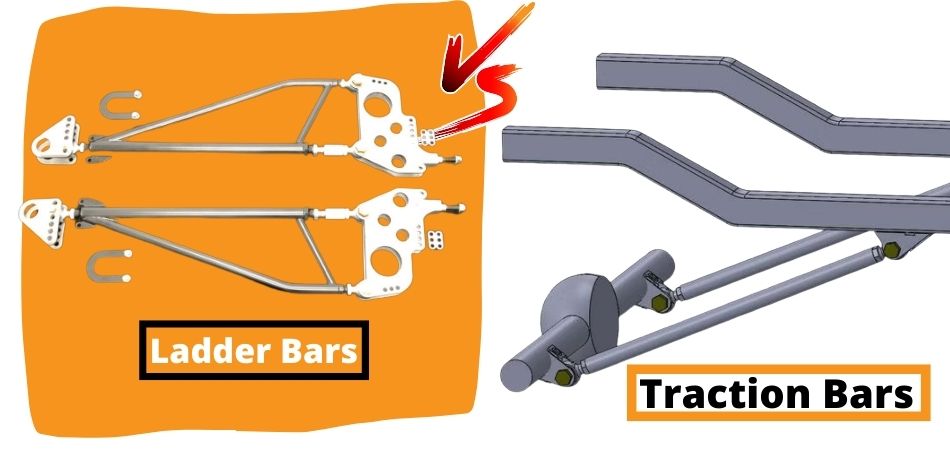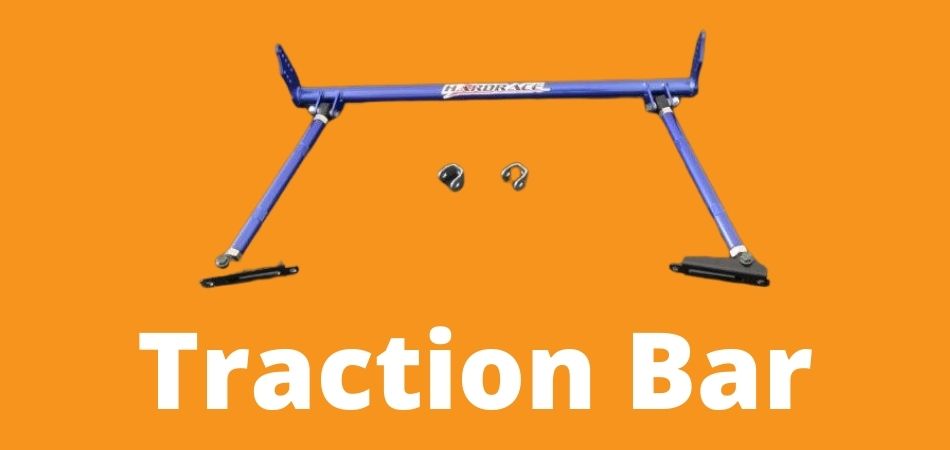Have you been experiencing a loss of traction when hard accelerating your truck? Have your wheels been hopping with each hard brake or while climbing uphill?
Loss of traction is caused by axle wrap, that is the torque from deceleration or acceleration that rotates the axle housing. This rotation causes a twist on the leaf spring and further wheels losing traction. It happens in the blink of an eye and the wheel hops until traction is regained.
Wheel hop and axle wrap can easily damage your truck suspension. It also affects the driveline components making driving difficult and dangerous.
Ladder bars and traction bars are used to hold the axle in the right position, thus regaining lost traction. This brings us to the main debate; ladder bars vs traction bars- which one should you use?
If you’re still sitting on the fence, don’t worry. This article will explain all you need to know about ladder bars and traction, their similarities and differences, and where to best use them. Keep reading to find out more.
Ladder Bars Vs Traction Bars – The Basic Differences
Ladder bars and traction bars do the same job of eliminating axle wrap, preventing your truck wheels to hop and losing traction. Before we fully dive into the ladder bars vs traction bars debate, let’s first understand what they are.

What Is A Ladder Bar?
A ladder bar is a vehicle suspension tool used to prevent the wheel from hopping on coil spring trucks. Like a safe ladder for cleaning gutters, a ladder bar is ladder-shaped and gets narrower towards the top.
It is usually fitted at the back of a truck, on the spring perch, and then connected to the vehicle’s chassis at the front end of rear tires. Lader bars mount at the bottom and top of the axle.

When the vehicle suddenly accelerates, the tires begin to build traction. The ladder bar prevents the hind section from wrapping and letting the rear tires hop off the road. If it frequently happens, wheel hop can cause serious damage to the axle, hind section, chassis, and body of your vehicle.
You can use a ladder bar to help in traction for off-road vehicles, such as four-wheel-drive trucks. In this case, it prevents the front axle from rotating, making the vehicle more sure-footed and stable in poor traction environments.
Also, this method can be used to upgrade the braking system; since it removes the slope that wraps up the axle.
What Is A Traction Bar?
A traction bar is a solid metal bar attached to either side of a vehicle’s rear axle that connects with Heim’s joints to the chassis. It helps prevent axle wrap while allowing the suspension to function as expected.
The traction bar ensures the amount of torque applied to the wheels is sufficient to keep your vehicle going straight down a descent without slipping.

When you lift a vehicle, you amplify the axle wrap allowed by the suspension. This moves the axle away from the leaf springs and further amplifies the axle wrap. Without a traction bar, you can cause damage to the axle housing in high-stress conditions.
Ladder Bars Vs Traction Bars: A Head-to-Head Comparison
The primary similarity between ladder bars and traction bars is they both reduce axle wrap and help your vehicle regain lost traction when accelerating or decelerating.
While ladder bars and traction bars perform a similar job, they are not the same. There are a number of significant differences between the two. Let’s talk about some of these differences in functionality, intended purpose, price, etc.
Here are Some Differences between Ladder Bars and Traction Bars
- Ladder bars have two separate points where they attach to the axle, one at the bottom while the other one at the top of the axle with a single mount on the chassis. On the other hand, Traction bars have only one attachment at the bottom of the axle and a single mount on the chassis to allow maximum articulation of the suspension.
- Looking at cost, the price of ladder bars is usually higher than that of traction bars. Ladder bars are expensive because they are a little more complicated, strong and durable pieces of equipment. A high-quality pair of ladder bars can cost as much as five hundred dollars.
- Ladder bars are suitable for off-road driving. They offer excellent handling while driving and turning on rugged terrain. Traction bars are ideal for on-road (pavement) driving. They offer more stability while driving on level surfaces like tarmac or leveled gravel.
- While ladder bars are used to hold the axle in the right position, traction bars are used to assist the wheel hop by changing the rotation angle of the hind axle.
Below is a summary table that shows the difference between ladder bars and traction bars.
| Ladder Bars | Traction Bars |
| They decrease axle hop, thus increasing traction and acceleration. | They decrease wheel hop and boost rear suspension. |
| These are heavy. | These are light-weight. |
| These are expensive. | These are cost-effective. |
| Built for off-road driving. | Built for on-road. |
| Holds the rear axle in the correct position. | Changes the rotation angle of the axle. |
Ladder Bars Vs Traction Bars: Pros and Cons
If you are concerned about your vehicle’s axle wrap, then adding ladder bars or traction bars would be a perfect idea. While they both offer a robust axle wrap prevention solution, each has its strengths and drawbacks. Here are some pros and cons of using ladder bars and traction bars:
Ladder Bars
Pros:
- Super effective – the triangular shape of ladder bars makes them the most effective way of deterring axle wrap.
- Does not bind during flex – They do not bind with the up/down flexes of the suspension, especially if they are long enough.
- Durable – Ladder bars built for heavy-duty vehicles are super strong and durable; they don’t cave in easily.
- High suspension – When installed, ladder bars do not hang so low to interfere with ground clearance.
Cons:
- They are expensive – Generally, ladder bars are more costly than traction bars.
- Not much grip – These bars do not provide much grip. When using ladder bars, you may not be able to pull harder from a stop or negotiate corners rapidly.
Traction Bars
Pros:
- Light-weight – Tractions bars weigh much less compared to ladder bars.
- Easy installation – They are simple, thus providing a non-complex axle wrap stoppage mechanism.
Cons:
- Less articulation – These bars have inadequate articulation since the spring and bar often bind. Although you can boost the motion range, it can’t be any better than ladder bars.
- Minimizes ground clearance – Traction bars have lower mounts that allow the springs to bend less from natural compression. However, this negatively affects your vehicle’s ground clearance.
Final Thoughts
Wheel hopping during acceleration or deceleration, or hard braking is a symptom of axle wrap. It happens when the leaf spring twists; hence your truck loses traction.
Traction bars are essential if your purpose is to run a lift kit or race. You can easily build enough traction to wrap the axle until the driveshaft snaps if you intend to do boosted launches on your vehicle.
If you are looking for something more rigid, reliable, and durable for off-road driving, ladder bars would be your best pick.
However, if you are a pavement or tarmac cruiser, you can opt for traction bars. Remember, it’s essential to use them properly to enjoy the benefit of their added functionality.